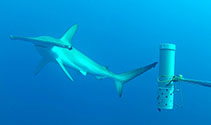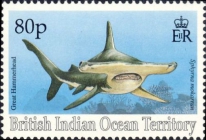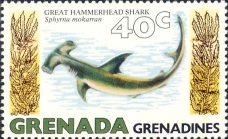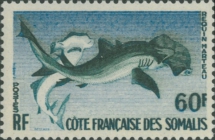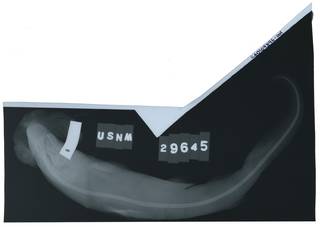WoRMS taxon details
Sphyrna mokarran (Rüppell, 1837)
105817 (urn:lsid:marinespecies.org:taxname:105817)
accepted
Species
Sphyrna ligo Fraser-Brunner, 1950 · unaccepted
Sphyrna mokorran Rüppell, 1837 · unaccepted (misspelling)
Sphyrna mukaran (Rüppell, 1837) · unaccepted > misspelling - incorrect subsequent spelling
Zygaena dissimilis Murray, 1887 · unaccepted
Zygaena mokarran Rüppell, 1837 · unaccepted
marine, brackish, fresh, terrestrial
(of Zygaena mokarran Rüppell, 1837) Rüppell, W. P. E. S. (1835-1838). Neue Wirbelthiere zu der Fauna von Abyssinien gehörig Fische des Rothen Meeres. <em>Siegmund Schmerber, Frankfurt am Main.</em> i-ii + 1-148, Pls. 1-33. [1835:1-28, Pls. 1-7; 1836:29-52, Pls. 8-14; 1837:53-80, Pls. 15-21; 1838:81-148, Pls. 22-33.]. [For dates see Sawyer 1952 [ref. 13582].]. [details]
Description A coastal-pelagic, semi-oceanic shark, found close inshore and well offshore, over the continental shelves, island...
Distribution North Carolina to Uruguay (highly migratory species)
Description A coastal-pelagic, semi-oceanic shark, found close inshore and well offshore, over the continental shelves, island terraces, and in passes and lagoons. Nomadic and migratory. Feeds on small bony fishes, crabs and squid, also on other sharks, rays, and lobsters. Viviparous, with 13 to 38 young in a litter. Size at birth 50 to 70 cm. Potentially dangerous. Meat utilized for human consumption, liver oil for vitamins, fins for soup, and hides for leather. [details]
Distribution North Carolina to Uruguay (highly migratory species)
Distribution North Carolina to Uruguay (highly migratory species) [details]
Froese, R. and D. Pauly. Editors. (2024). FishBase. Sphyrna mokarran (Rüppell, 1837). Accessed through: World Register of Marine Species at: https://www.marinespecies.org/aphia.php?p=taxdetails&id=105817 on 2024-11-21
Date
action
by
![]() The webpage text is licensed under a Creative Commons Attribution-Noncommercial 4.0 License
The webpage text is licensed under a Creative Commons Attribution-Noncommercial 4.0 License
original description
(of Zygaena mokarran Rüppell, 1837) Rüppell, W. P. E. S. (1835-1838). Neue Wirbelthiere zu der Fauna von Abyssinien gehörig Fische des Rothen Meeres. <em>Siegmund Schmerber, Frankfurt am Main.</em> i-ii + 1-148, Pls. 1-33. [1835:1-28, Pls. 1-7; 1836:29-52, Pls. 8-14; 1837:53-80, Pls. 15-21; 1838:81-148, Pls. 22-33.]. [For dates see Sawyer 1952 [ref. 13582].]. [details]
context source (Deepsea) Intergovernmental Oceanographic Commission (IOC) of UNESCO. The Ocean Biogeographic Information System (OBIS), available online at http://www.iobis.org/ [details]
context source (HKRMS) Hong Kong marine fish database. <em>AFCD.</em> , available online at https://www.hk-fish.net/en/fish/introduction/ [details]
context source (PeRMS) Chirichigno, N.; Cornejo, M. (2001). Catálogo comentado de los peces marinos del Perú. <em>2ª ed. Instituto del Mar de Perú. Publicación Especial. Callao.</em> 314 p. [details]
basis of record van der Land, J.; Costello, M.J.; Zavodnik, D.; Santos, R.S.; Porteiro, F.M.; Bailly, N.; Eschmeyer, W.N.; Froese, R. (2001). Pisces, <B><I>in</I></B>: Costello, M.J. <i>et al.</i> (Ed.) (2001). <i>European register of marine species: a check-list of the marine species in Europe and a bibliography of guides to their identification. Collection Patrimoines Naturels,</i> 50: pp. 357-374 (look up in IMIS) [details]
additional source Streftaris, N., A. Zenetos & E. Papathanassiou. (2005). Globalisation in marine ecosystems: the story of non-indigenous marine species across European seas. <em>Oceanogry and Marine Biology: an Annual Review.</em> 43: 419-453. (look up in IMIS) [details] Available for editors [request]
[request]
additional source Zenetos, A.; Çinar, M.E.; Pancucci-Papadopoulou, M.A.; Harmelin, J.-G.; Furnari, G.; Andaloro, F.; Bellou, N.; Streftaris, N.; Zibrowius, H. (2005). Annotated list of marine alien species in the Mediterranean with records of the worst invasive species. <em>Mediterranean Marine Science.</em> 6 (2): 63-118., available online at https://www.researchgate.net/publication/273213810_Annotated_list_of_marine_alien_species_in_the_Mediterranean_with_records_of_the_worst_invasive_species [details] Available for editors [request]
[request]
additional source McEachran, J. D. (2009). Fishes (Vertebrata: Pisces) of the Gulf of Mexico, Pp. 1223–1316 in: Felder, D.L. and D.K. Camp (eds.), Gulf of Mexico–Origins, Waters, and Biota. Biodiversity. Texas A&M Press, College Station, Texas. [details]
additional source Liu, J.Y. [Ruiyu] (ed.). (2008). Checklist of marine biota of China seas. <em>China Science Press.</em> 1267 pp. (look up in IMIS) [details] Available for editors [request]
[request]
additional source Zenetos, A.; Gofas, S.; Verlaque, M.; Cinar, M.; Garcia Raso, J.; Bianchi, C.; Morri, C.; Azzurro, E.; Bilecenoglu, M.; Froglia, C.; Siokou, I.; Violanti, D.; Sfriso, A.; San Martin, G.; Giangrande, A.; Katagan, T.; Ballesteros, E.; Ramos-Espla, A.; Mastrototaro, F.; Ocana, O.; Zingone, A.; Gambi, M.; Streftaris, N. (2010). Alien species in the Mediterranean Sea by 2010. A contribution to the application of European Union's Marine Strategy Framework Directive (MSFD). Part I. Spatial distribution. <em>Mediterranean Marine Science.</em> 11(2): 381-493., available online at https://doi.org/10.12681/mms.87 [details]
additional source Froese, R. & D. Pauly (Editors). (2024). FishBase. World Wide Web electronic publication. version (06/2024)., available online at https://www.fishbase.org [details]
ecology source Looby, A.; Erbe, C.; Bravo, S.; Cox, K.; Davies, H. L.; Di Iorio, L.; Jézéquel, Y.; Juanes, F.; Martin, C. W.; Mooney, T. A.; Radford, C.; Reynolds, L. K.; Rice, A. N.; Riera, A.; Rountree, R.; Spriel, B.; Stanley, J.; Vela, S.; Parsons, M. J. G. (2023). Global inventory of species categorized by known underwater sonifery. <em>Scientific Data.</em> 10(1). (look up in IMIS), available online at https://doi.org/10.1038/s41597-023-02745-4 [details]
context source (Deepsea) Intergovernmental Oceanographic Commission (IOC) of UNESCO. The Ocean Biogeographic Information System (OBIS), available online at http://www.iobis.org/ [details]
context source (HKRMS) Hong Kong marine fish database. <em>AFCD.</em> , available online at https://www.hk-fish.net/en/fish/introduction/ [details]
context source (PeRMS) Chirichigno, N.; Cornejo, M. (2001). Catálogo comentado de los peces marinos del Perú. <em>2ª ed. Instituto del Mar de Perú. Publicación Especial. Callao.</em> 314 p. [details]
basis of record van der Land, J.; Costello, M.J.; Zavodnik, D.; Santos, R.S.; Porteiro, F.M.; Bailly, N.; Eschmeyer, W.N.; Froese, R. (2001). Pisces, <B><I>in</I></B>: Costello, M.J. <i>et al.</i> (Ed.) (2001). <i>European register of marine species: a check-list of the marine species in Europe and a bibliography of guides to their identification. Collection Patrimoines Naturels,</i> 50: pp. 357-374 (look up in IMIS) [details]
additional source Streftaris, N., A. Zenetos & E. Papathanassiou. (2005). Globalisation in marine ecosystems: the story of non-indigenous marine species across European seas. <em>Oceanogry and Marine Biology: an Annual Review.</em> 43: 419-453. (look up in IMIS) [details] Available for editors
additional source Zenetos, A.; Çinar, M.E.; Pancucci-Papadopoulou, M.A.; Harmelin, J.-G.; Furnari, G.; Andaloro, F.; Bellou, N.; Streftaris, N.; Zibrowius, H. (2005). Annotated list of marine alien species in the Mediterranean with records of the worst invasive species. <em>Mediterranean Marine Science.</em> 6 (2): 63-118., available online at https://www.researchgate.net/publication/273213810_Annotated_list_of_marine_alien_species_in_the_Mediterranean_with_records_of_the_worst_invasive_species [details] Available for editors
additional source McEachran, J. D. (2009). Fishes (Vertebrata: Pisces) of the Gulf of Mexico, Pp. 1223–1316 in: Felder, D.L. and D.K. Camp (eds.), Gulf of Mexico–Origins, Waters, and Biota. Biodiversity. Texas A&M Press, College Station, Texas. [details]
additional source Liu, J.Y. [Ruiyu] (ed.). (2008). Checklist of marine biota of China seas. <em>China Science Press.</em> 1267 pp. (look up in IMIS) [details] Available for editors
additional source Zenetos, A.; Gofas, S.; Verlaque, M.; Cinar, M.; Garcia Raso, J.; Bianchi, C.; Morri, C.; Azzurro, E.; Bilecenoglu, M.; Froglia, C.; Siokou, I.; Violanti, D.; Sfriso, A.; San Martin, G.; Giangrande, A.; Katagan, T.; Ballesteros, E.; Ramos-Espla, A.; Mastrototaro, F.; Ocana, O.; Zingone, A.; Gambi, M.; Streftaris, N. (2010). Alien species in the Mediterranean Sea by 2010. A contribution to the application of European Union's Marine Strategy Framework Directive (MSFD). Part I. Spatial distribution. <em>Mediterranean Marine Science.</em> 11(2): 381-493., available online at https://doi.org/10.12681/mms.87 [details]
additional source Froese, R. & D. Pauly (Editors). (2024). FishBase. World Wide Web electronic publication. version (06/2024)., available online at https://www.fishbase.org [details]
ecology source Looby, A.; Erbe, C.; Bravo, S.; Cox, K.; Davies, H. L.; Di Iorio, L.; Jézéquel, Y.; Juanes, F.; Martin, C. W.; Mooney, T. A.; Radford, C.; Reynolds, L. K.; Rice, A. N.; Riera, A.; Rountree, R.; Spriel, B.; Stanley, J.; Vela, S.; Parsons, M. J. G. (2023). Global inventory of species categorized by known underwater sonifery. <em>Scientific Data.</em> 10(1). (look up in IMIS), available online at https://doi.org/10.1038/s41597-023-02745-4 [details]
 Present
Present  Present in aphia/obis/gbif/idigbio
Present in aphia/obis/gbif/idigbio  Inaccurate
Inaccurate  Introduced: alien
Introduced: alien  Containing type locality
Containing type locality
Unreviewed
Description A coastal-pelagic, semi-oceanic shark, found close inshore and well offshore, over the continental shelves, island terraces, and in passes and lagoons. Nomadic and migratory. Feeds on small bony fishes, crabs and squid, also on other sharks, rays, and lobsters. Viviparous, with 13 to 38 young in a litter. Size at birth 50 to 70 cm. Potentially dangerous. Meat utilized for human consumption, liver oil for vitamins, fins for soup, and hides for leather. [details]Diet Feeds on stingrays and other batoids, groupers and sea catfishes, but also preys on other small bony fishes, crabs, squid, other sharks, rays, and lobsters [details]
Distribution North Carolina to Uruguay (highly migratory species) [details]
Habitat nektonic [details]
Habitat Found at depths of 1 - 300m. [details]
Importance Social- Commercial, fisheries [details]
Reproduction Viviparous species, produces 13-42 of 56 to 70 cm young a litter [details]
| Language | Name | |
|---|---|---|
| English | great hammerhead sharkgreat hammerhead | [details] |
| German | großer Hammerhai | [details] |
| Japanese | ヒラシュモクザメ | [details] |
| Lithuanian | didysis kūjaryklis | [details] |
| Polish | głowomłot olbrzymi | [details] |
| Russian | акула-молот гигантская | [details] |
| Spanish | tiburón martillo gigantecornuda gigante | [details] |
| Turkish | dev çekiçbaş | [details] |
To Barcode of Life (112 barcodes)
To Biodiversity Heritage Library (12 publications) (from synonym Zygaena mokarran Rüppell, 1837)
To Biodiversity Heritage Library (2 publications) (from synonym Sphyrna ligo Fraser-Brunner, 1950)
To Biodiversity Heritage Library (30 publications)
To Biodiversity Heritage Library (6 publications) (from synonym Zygaena dissimilis Murray, 1887)
To Biological Information System for Marine Life (BISMaL)
To European Nucleotide Archive, ENA (Sphyrna mokarran)
To FishBase (from synonym Zygaena mokarran Rüppell, 1837)
To FishBase (from synonym Zygaena dissimilis Murray, 1887)
To FishBase
To FishBase (from synonym Sphyrna ligo Fraser-Brunner, 1950)
To FishBase (from synonym Sphyrna mokorran Rüppell, 1837)
To FishBase images (Sphyrna mokarran, New Caledonia, by University of Western Australia (UWA))
To Fishipedia
To GenBank (1898 nucleotides; 122 proteins)
To GenBank (1898 nucleotides; 122 proteins) (from synonym Zygaena mokarran Rüppell, 1837)
To Global Biotic Interactions (GloBI)
To IUCN Red List (Critically Endangered)
To NMNH Extant Collection (Sphyrna mokarran RAD109846-001)
To NMNH Extant Collection (Sphyrna mokarran RAD109846-001)
To PESI
To ITIS
To Biodiversity Heritage Library (12 publications) (from synonym Zygaena mokarran Rüppell, 1837)
To Biodiversity Heritage Library (2 publications) (from synonym Sphyrna ligo Fraser-Brunner, 1950)
To Biodiversity Heritage Library (30 publications)
To Biodiversity Heritage Library (6 publications) (from synonym Zygaena dissimilis Murray, 1887)
To Biological Information System for Marine Life (BISMaL)
To European Nucleotide Archive, ENA (Sphyrna mokarran)
To FishBase (from synonym Zygaena mokarran Rüppell, 1837)
To FishBase (from synonym Zygaena dissimilis Murray, 1887)
To FishBase
To FishBase (from synonym Sphyrna ligo Fraser-Brunner, 1950)
To FishBase (from synonym Sphyrna mokorran Rüppell, 1837)
To FishBase images (Sphyrna mokarran, New Caledonia, by University of Western Australia (UWA))
To Fishipedia
To GenBank (1898 nucleotides; 122 proteins)
To GenBank (1898 nucleotides; 122 proteins) (from synonym Zygaena mokarran Rüppell, 1837)
To Global Biotic Interactions (GloBI)
To IUCN Red List (Critically Endangered)
To NMNH Extant Collection (Sphyrna mokarran RAD109846-001)
To NMNH Extant Collection (Sphyrna mokarran RAD109846-001)
To PESI
To ITIS
